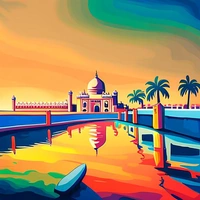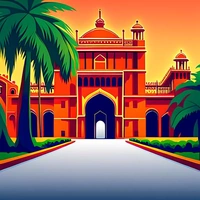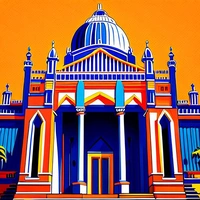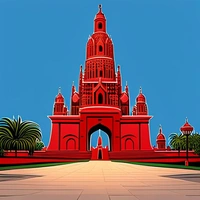
City’s History in Brief in Chennai, Tamil Nādu, India

1. Fort St. George
Fort St. George is the first English fortress in India, built in 1644. It marks the beginning of British influence in Chennai. The fort now houses the Tamil Nadu legislative assembly and a museum.
- Historical Significance: First British establishment in India.
- Architecture: Features colonial-era architecture.
- Museum: Contains artifacts from the British era.
- Government Building: Houses the Tamil Nadu legislative assembly.

2. Kapaleeshwarar Temple
This ancient temple is dedicated to Lord Shiva and showcases Dravidian architecture. It is believed to have been built in the 7th century CE. The temple is a vibrant center of culture and spirituality.
- Religious Importance: A major pilgrimage site for Hindus.
- Architecture: Features classic Dravidian style.
- Cultural Hub: Hosts various cultural events and festivals.
- Historical Age: Dates back to the 7th century.

3. San Thome Basilica
Built over the tomb of Saint Thomas, one of the twelve apostles of Jesus, this basilica is a significant Christian site. It was originally constructed in the 16th century by Portuguese explorers. The church is known for its neo-gothic architecture.
- Religious Significance: Built over the tomb of an apostle.
- Architecture: Features neo-gothic style.
- Historical Origin: Constructed by Portuguese explorers.
- Cultural Importance: A key site for Christian pilgrims.

4. Government Museum
Established in 1851, this is the second oldest museum in India. It houses a rich collection of artifacts, including South Indian bronzes and archaeological finds. The museum is a treasure trove for history enthusiasts.
- Historical Artifacts: Contains ancient bronzes and relics.
- Age: Second oldest museum in India.
- Diverse Collection: Includes art, archaeology, and natural history.
- Educational Value: Offers insights into South Indian history.

5. Vivekananda House
This historic building is where Swami Vivekananda stayed in 1897 after his return from the West. It is now a museum dedicated to his life and teachings. The house is a place of inspiration for many visitors.
- Historical Residence: Swami Vivekananda's temporary home.
- Museum: Dedicated to Vivekananda's teachings.
- Cultural Significance: A place of inspiration and learning.
- Architectural Style: Features colonial architecture.

6. Ripon Building
Completed in 1913, the Ripon Building is the seat of the Chennai Corporation. It is an example of Indo-Saracenic architecture. The building is named after Lord Ripon, a former Viceroy of India.
- Government Function: Houses the Chennai Corporation.
- Architectural Style: Indo-Saracenic design.
- Historical Naming: Named after Lord Ripon.
- Construction Date: Completed in 1913.

7. Madras High Court
One of the oldest high courts in India, established in 1862. The building is a fine example of Indo-Saracenic architecture. It is a functioning court and a landmark of legal history in Chennai.
- Judicial Importance: One of India's oldest high courts.
- Architectural Style: Indo-Saracenic design.
- Operational Status: Still functions as a court.
- Historical Establishment: Established in 1862.

8. St. Mary's Church
Located within Fort St. George, St. Mary's Church is the oldest Anglican church in India. It was consecrated in 1680 and is known for its beautiful stained glass windows. The church is a serene spot amidst the bustling city.
- Religious Heritage: Oldest Anglican church in India.
- Location: Situated within Fort St. George.
- Architectural Features: Noted for stained glass windows.
- Consecration Date: Consecrated in 1680.

9. Egmore Railway Station
Opened in 1908, Egmore Railway Station is a key railway hub in Chennai. It features a unique blend of Gothic and Romanesque architectural styles. The station is a gateway to the southern parts of India.
- Transport Hub: Major railway station in Chennai.
- Architectural Style: Gothic and Romanesque design.
- Historical Opening: Opened in 1908.
- Connectivity: Links to southern India.

10. Anna Memorial
This memorial is dedicated to C.N. Annadurai, a former Chief Minister of Tamil Nadu. It is located on Marina Beach and is a popular spot for visitors. The memorial is a symbol of Tamil pride and political history.
- Political Significance: Dedicated to a former Chief Minister.
- Location: Situated on Marina Beach.
- Cultural Symbol: Represents Tamil pride.
- Visitor Attraction: Popular spot for tourists.
